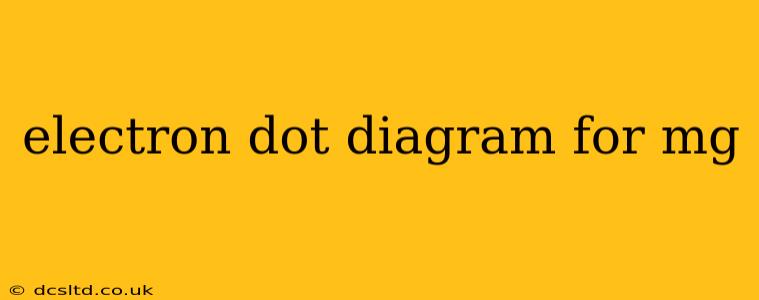Magnesium (Mg) is an alkaline earth metal with atomic number 12. Understanding its electron configuration is crucial to predicting its chemical behavior. This article will explain how to draw the electron dot diagram for magnesium and explore related concepts.
What is an Electron Dot Diagram?
An electron dot diagram, also known as a Lewis dot structure, is a simplified representation of an atom's valence electrons. Valence electrons are the electrons in the outermost shell of an atom, and they are the ones involved in chemical bonding. The diagram uses dots to represent these valence electrons, placed around the element's symbol.
How to Draw the Electron Dot Diagram for Magnesium (Mg)
-
Determine the number of valence electrons: Magnesium has an atomic number of 12, meaning it has 12 electrons. Its electron configuration is 1s²2s²2p⁶3s². The outermost shell (3s²) contains two electrons. Therefore, magnesium has two valence electrons.
-
Write the element symbol: Write the symbol for magnesium, "Mg," in the center.
-
Place the valence electrons: Place two dots around the magnesium symbol, representing the two valence electrons. It's common practice to place one dot on each side before pairing them up. You don't need to be precise about their placement, as long as they're all around the symbol.
Therefore, the electron dot diagram for magnesium is:
.Mg.
Why is the Electron Dot Diagram Important?
The electron dot diagram is a valuable tool for several reasons:
-
Predicting Chemical Bonding: It helps visualize how magnesium will react with other atoms. Magnesium, with its two valence electrons, tends to lose these electrons to achieve a stable octet (eight electrons in its outermost shell), forming Mg²⁺ ions. This explains its reactivity and the formation of ionic compounds.
-
Understanding Chemical Properties: The diagram simplifies the understanding of magnesium's chemical properties, such as its tendency to form ionic bonds and its relatively high reactivity compared to other elements.
-
Visualizing Chemical Reactions: It can be used to illustrate how magnesium interacts with other atoms during chemical reactions, providing a visual representation of electron transfer or sharing.
What are some common misconceptions about electron dot diagrams?
Are the dots always placed in a specific order?
No, the exact placement of the dots around the element symbol is not strictly defined. As long as you represent the correct number of valence electrons, the diagram is considered correct.
Can I use x's instead of dots?
While dots are the most common representation, some people use x's or other symbols. The important thing is consistency and clarity.
Does the diagram show all the electrons in the atom?
No, it only shows the valence electrons, which are the electrons involved in chemical bonding. The inner electrons are not included in the diagram.
How does the electron dot diagram for magnesium compare to other elements?
Elements in the same group (column) of the periodic table have the same number of valence electrons and, therefore, similar electron dot diagrams. For example, beryllium (Be) in the same group as magnesium would also have two dots in its electron dot diagram. However, elements in different groups have different numbers of valence electrons, leading to different diagrams and different chemical properties.
This article provides a comprehensive understanding of the electron dot diagram for magnesium, its significance in understanding chemical bonding and properties, and clarifies some common misconceptions. By mastering this concept, one can better understand the fundamental principles of chemistry.
